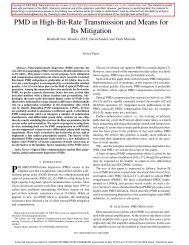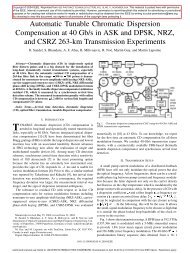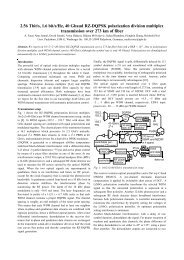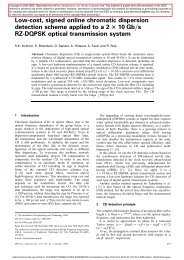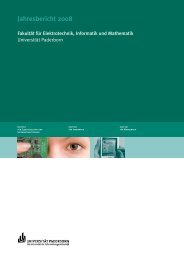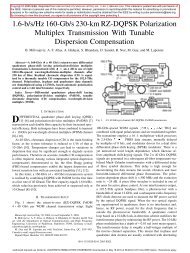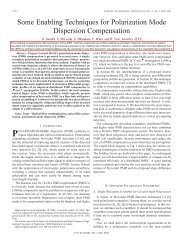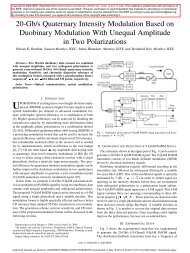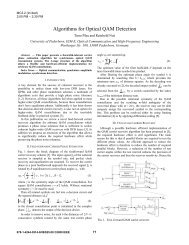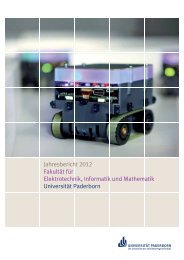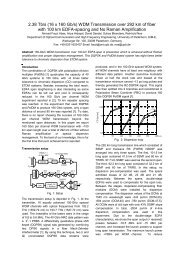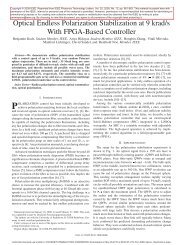Multiplier-free Realtime Phase Tracking for Coherent QPSK Receivers
Multiplier-free Realtime Phase Tracking for Coherent QPSK Receivers
Multiplier-free Realtime Phase Tracking for Coherent QPSK Receivers
You also want an ePaper? Increase the reach of your titles
YUMPU automatically turns print PDFs into web optimized ePapers that Google loves.
Copyright © 2009 IEEE. Reprinted from IEEE Photonics Technology Letters, VOL. 21, No. 3, pp. 137-139, FEBRUARY 1, 2009. This material is<br />
posted IEEE PHOTONICS here with permission TECHNOLOGY of the LETTERS, IEEE. Internal VOL. 21, or NO. personal 3, FEBRUARY use of 1, this 2009material is permitted. However, permission to reprint/republish this material 137<br />
<strong>for</strong> advertising or promotional purposes or <strong>for</strong> creating new collective works <strong>for</strong> resale or redistribution must be obtained from the IEEE by writing to<br />
pubs-permissions@ieee.org. By choosing to view this document, you agree to all provisions of the copyright laws protecting it.<br />
<strong>Multiplier</strong>-Free Real-Time <strong>Phase</strong> <strong>Tracking</strong> <strong>for</strong><br />
<strong>Coherent</strong> <strong>QPSK</strong> <strong>Receivers</strong><br />
Sebastian Hoffmann, Ralf Peveling, Timo Pfau, Olaf Adamczyk, Ralf Eickhoff, and Reinhold Noé<br />
Abstract—This letter presents a hardware-efficient phase estimation<br />
algorithm that can replace the common complex estimators<br />
<strong>for</strong> a coherent quadrature phase-shift keying transmission system.<br />
Index Terms—Optical communication, phase estimation,<br />
quadrature phase-shift keying (<strong>QPSK</strong>), synchronous detection.<br />
I. INTRODUCTION<br />
QUADRATURE phase-shift keying (<strong>QPSK</strong>) is a complex<br />
modulation <strong>for</strong>mat that has been the subject of several<br />
recent coherent detection real-time transmission experiments<br />
[1]–[4]. The major challenge of coherent <strong>QPSK</strong> transmission<br />
is the combination of general noise reduction combined<br />
with phase noise tracking, especailly when standard distributed<br />
feedback (DFB) lasers are employed. Synchronous detection<br />
with digital feed<strong>for</strong>ward phase estimators allows us to employ<br />
DFB lasers [1], [3], [5].<br />
Fig. 1 shows the coherent receiver with the digital signal<br />
processing unit (DSPU). Sampled pairs of and are represented<br />
as complex numbers and demultiplexed <strong>for</strong> parallel processing.<br />
If both frequency compensation and phase estimation<br />
were omitted, the receiver would be called asynchronous or differential.<br />
Differential encoding of the transmitted symbols enables<br />
such a data recovery based only on the received symbol<br />
and its predecessor. Frequency compensation is an alternative or<br />
a complement to the electronic local oscillator laser frequency<br />
control.<br />
To remove the <strong>QPSK</strong> modulation in the phase estimator, it<br />
is common practice to raise the complex input signal or its normalized<br />
phasor to the power of 4. Afterwards, the additive noise<br />
is reduced by a low-pass filter, often a moving average over<br />
, where is a small integer constant [5]–[9].<br />
In a parallelized DSPU, it causes much ef<strong>for</strong>t to provide estimated<br />
phase values <strong>for</strong> each received symbol. In order to reduce<br />
Manuscript received September 11, 2008; revised October 14, 2008. First<br />
published November 21, 2008; current version published January 14, 2009.<br />
S. Hoffmann, R. Peveling, T. Pfau, and R. Noé are with the Institute of<br />
Electrical Engineering, University of Paderborn, 33098 Paderborn, Germany<br />
(e-mail: hoffmann@ont.uni-paderborn.de; peveling@hni.uni-paderborn.de;<br />
pfau@ont.uni-paderborn.de; noe@ont.uni-paderborn.de).<br />
O. Adamczyk was with the Institute of Electrical Engineering, University of<br />
Paderborn, 33098 Paderborn, Germany, and is now with Nokia Siemens Networks,<br />
81379 München, Germany (e-mail: olaf.adamczyk@nsn.com).<br />
R. Eickhoff was with the Institute of Electrical Engineering, University of<br />
Paderborn, 33098 Paderborn, Germany, and is now with the Institute of Electrical<br />
Engineering, Technical Univeristy of Dresden, 01062 Dresden (e-mail:<br />
ralf.eickhoff@tu-dresden.de).<br />
Color versions of one or more of the figures in this letter are available online<br />
at http://ieeexplore.ieee.org.<br />
Digital Object Identifier 10.1109/LPT.2008.2009228<br />
Fig. 1. <strong>Coherent</strong> <strong>QPSK</strong> receiver with DSPU. The DSPU processes M data<br />
streams in parallel.<br />
this ef<strong>for</strong>t, block phase estimators generate only a single estimation<br />
value of symbols processed in parallel [10], [11], but<br />
they are more sensitive to phase noise than averaging window<br />
estimators.<br />
We propose to employ an angle-based approach similar to<br />
the barycenter algorithm used <strong>for</strong> burst mode transmission in<br />
satelite communication [12]. This angle-based method avoids<br />
the complex calculations of usual phase estimators. Like the<br />
predecision-based method presented in [10], our approach is<br />
multiplier-<strong>free</strong>, but it does not require feedback and allows realtime<br />
tracking, not only block phase estimation. Moreover, the<br />
structure of the estimator allows us to use several intermediate<br />
results twice in the parallel processing which reduces the total<br />
ef<strong>for</strong>t. The low hardware ef<strong>for</strong>t was especially advantageous <strong>for</strong><br />
the field programmable gate array implementation of this algorithm,<br />
used <strong>for</strong> the first real-time <strong>QPSK</strong> transmission [1] and<br />
also polarization multiplex and control [3].<br />
II. RECEIVER WITH COMPLEX PHASE ESTIMATOR<br />
The received symbols can be described as a sequence of complex<br />
numbers with time index<br />
consists of the <strong>QPSK</strong> symbol multiplied by a timevariant<br />
phasor, and additive channel noise . The phasor is<br />
essentially a random factor representing the phase noise of both<br />
lasers. For the data recovery, only the argument of the received<br />
symbol is necessary [5], [7], [10]. For uniqueness, the operation<br />
is frequently added. The resulting positive angle is the<br />
(1)<br />
1041-1135/$25.00 © 2009 IEEE<br />
Authorized licensed use limited to: UNIVERSITATSBIBLIOTHEK PADERBORN. Downloaded on April 22, 2009 at 15:16 from IEEE Xplore. Restrictions apply.
138 IEEE PHOTONICS TECHNOLOGY LETTERS, VOL. 21, NO. 3, FEBRUARY 1, 2009<br />
sum of three different angles<br />
(2)<br />
The <strong>QPSK</strong> modulation contributes<br />
, while<br />
the additive channel noise contribution is . For phase estimation,<br />
it is necessary to remove the <strong>QPSK</strong> modulation. For an<br />
angle-based approach, a fold function can be employed which<br />
can simply be implemented by removing the first two bits of the<br />
argument in twos-complement representation [12]. We prefer<br />
the modulo operation to describe the effect of folding function<br />
in the following definition:<br />
Fig. 2. Angle-based phase estimator structure.<br />
(3)<br />
As desired, the positive angle is independent from the<br />
<strong>QPSK</strong> modulation, a property that it shares with and to<br />
which it is related as follows:<br />
Generating a modulation-<strong>free</strong> signal like is the task<br />
of the first stage of common complex phase estimators. An attractive<br />
alternative to is the normalized modulation-<strong>free</strong><br />
signal<br />
[7], [9]. A further improvement of the<br />
complex phase estimation can be achieved by weighted averaging<br />
[8], [9]. The novel idea is to employ a set of modulation<strong>free</strong><br />
position angles<br />
to<br />
obtain an estimated phase immediately, i.e., without function<br />
tables and complex calculations. Angle-based averaging<br />
equivalent to the barycenter algorithm [12] is used to obtain a<br />
sequence of estimated phase values in parallel. The proposed<br />
structure is very hardware-efficient and imitates weighted averaging<br />
by multiple usage of center values.<br />
III. ANGLE-BASED PHASE ESTIMATION<br />
The sliding window phase estimation process <strong>for</strong> a single estimation<br />
value can be described as a real-valued scalar<br />
function of a real-valued input vector with components.<br />
To obtain a sequence of estimated phase angles in parallel,<br />
an -dimensional vector function of an input vector with<br />
components is required<br />
Fig. 2 shows the proposed angle-based parallelized tree structure<br />
<strong>for</strong> and . The partial tree <strong>for</strong> the component<br />
consists of the seven marked nodes. The nodes are basic<br />
cells that convert pairs of position angles into average position<br />
angles . Basic cell functions are concatenated to<br />
<strong>for</strong>m the phase estimator. Due to multiple usage of intermediate<br />
results, the vectorized function in Fig. 2 requires only 17 basic<br />
cells instead of .<br />
In order to imitate the behaviour of a Viterbi & Viterbi estimator<br />
with normalization [7], [9], the partial result from each<br />
basic cell has to be<br />
(4)<br />
(5)<br />
(6)<br />
Fig. 3. Internal structure of the basic cell.<br />
The complex sum in (6) can be rewritten as<br />
with the sum and the difference of the<br />
input values. The argument of (7) depends on the exponent<br />
and the sign of the cosine function because a negative sign of<br />
is equivalent to a rotation by in the complex plane.<br />
Note that the cosine factor introduces a discontinuity of <strong>for</strong><br />
. Taking the further operations of (6) into account,<br />
we obtain an alternative calculation <strong>for</strong>mula <strong>for</strong> based on<br />
and only<br />
Fig. 3 shows the internal structure of the basic cell. The two<br />
input values are added to and subtracted from each other in parallel,<br />
and the final result is generated from the auxiliary quantities<br />
and according to (8), all within one DSPU clock cycle.<br />
The quantity is a directed phase increment that could be used<br />
<strong>for</strong> frequency estimation as described in [9]. The basic cell per<strong>for</strong>ms<br />
an interpolation of the phase track on the shortest possible<br />
path. The estimation quality can be improved by selection,<br />
i.e., elimination of intermediate results from critical pairs<br />
<strong>for</strong> which two possible paths have almost the same length. The<br />
acronym SMLPA (selective maximum likelihood phase approximation)<br />
refers to this feature.<br />
IV. SIMULATION RESULTS<br />
The algorithm SMLPA was compared to a normalized block<br />
phase estimator with and a normalized phase estimator<br />
with weighted averaging and in a Monte-Carlo simulation.<br />
is only important <strong>for</strong> the block phase estimator result,<br />
not <strong>for</strong> SMLPA or the weighted-normalized approach [9].<br />
SMLPA with as in Fig. 2 and a more complicated<br />
topology with was employed. Asynchronous data recovery<br />
was also simulated . Bit-error ratio (BER) over optical<br />
signal-to-noise ratio (OSNR) curves were simulated with<br />
(7)<br />
(8)<br />
Authorized licensed use limited to: UNIVERSITATSBIBLIOTHEK PADERBORN. Downloaded on April 22, 2009 at 15:16 from IEEE Xplore. Restrictions apply.
HOFFMANN et al.: MULTIPLIER-FREE REAL-TIME PHASE TRACKING FOR COHERENT <strong>QPSK</strong> RECEIVERS 139<br />
V. SUMMARY<br />
We have presented a novel and very hardware-efficient<br />
angle-based phase estimation algorithm that has proven to be<br />
a good replacement <strong>for</strong> the optimized moving average phase<br />
estimator. The presented simulation results <strong>for</strong> two different<br />
linewidth symbol rate ratios include asynchronous reception<br />
and block phase estimation.<br />
Fig. 4. BER/OSNR curves <strong>for</strong> different phase estimators <strong>for</strong> low phase noise.<br />
Fig. 5.<br />
BER/OSNR curves <strong>for</strong> different phase estimators <strong>for</strong> high phase noise.<br />
random symbols <strong>for</strong> each BER value. DFB lasers with 1-MHz<br />
linewidth are assumed.<br />
Fig. 4 shows the BER/OSNR results <strong>for</strong> a 28-GBaud system.<br />
With such a small relative linewidth, the block phase estimator<br />
per<strong>for</strong>ms almost as good as the other three phase estimators that<br />
track the phase drift.<br />
Fig. 5 shows simulated BER/OSNR curves <strong>for</strong> the same<br />
phase estimators and a 10-GBaud system with DFB lasers that<br />
have 1-MHz linewidth and a residual frequency mismatch of<br />
20 MHz. While the block phase estimator is not able to cope<br />
with high phase noise, both SMLPA versions have results<br />
similar to the weighted averaging method. They fulfill the high<br />
phase noise requirements of 10-GBaud transmission systems<br />
with coarsely controlled DFB lasers.<br />
REFERENCES<br />
[1] T. Pfau, S. Hoffmann, R. Peveling, S. Bhandare, S. Ibrahim, O. Adamczyk,<br />
M. Porrmann, R. Noé, and Y. Achiam, “First real-time data recovery<br />
<strong>for</strong> synchronous <strong>QPSK</strong> transmission with standard DFB lasers,”<br />
IEEE Photon. Technol. Lett., vol. 18, no. 18, pp. 1907–1909, Sep. 15,<br />
2006.<br />
[2] A. Leven, N. Kaneda, A. Klein, U.-V. Koc, and Y.-K. Chen, “Real-time<br />
implementation of 4.4 Gbit/s <strong>QPSK</strong> intradyne receiver using field programmable<br />
gate array,” Electron. Lett., vol. 42, no. 24, pp. 1421–1422,<br />
Nov. 23, 2006.<br />
[3] T. Pfau, R. Peveling, F. Samson, J. Romoth, S. Hoffmann, S. Bhandare,<br />
S. Ibrahim, D. Sandel, O. Adamczyk, M. Porrmann, R. Noé, J. Hauden,<br />
N. Grossard, H. Porte, D. Schlieder, A. Koslovsky, Y. Benarush, and<br />
Y. Achiam, “Polarisation-multiplexed 2.8 Gbit/s synchronous <strong>QPSK</strong><br />
transmission with real-time digital polarization tracking,” in ECOC<br />
2007, vol. 3, pp. 263–264, Paper We 8.3.3.<br />
[4] N. Kaneda, A. Leven, and Y.-K. Chen, “Block length effect on 5.0<br />
Gbit/s real-time <strong>QPSK</strong> intradyne receivers with standard DFB lasers,”<br />
Electron. Lett., vol. 43, no. 20, pp. 1106–1107, Sep. 27, 2007.<br />
[5] R. Noé, “<strong>Phase</strong> noise tolerant synchronous <strong>QPSK</strong>/BPSK basebandtype<br />
intradyne receiver concept with feed<strong>for</strong>ward carrier recovery,” J.<br />
Lightw. Technol., vol. 23, no. 2, pp. 802–802, Feb. 2005.<br />
[6] R. Noé, “PLL-<strong>free</strong> synchronous <strong>QPSK</strong> polarization multiplex/diversity<br />
receiver concept with digital I&Q baseband processing,” IEEE Photon.<br />
Technol. Lett., vol. 17, no. 4, pp. 887–889, Apr. 2005.<br />
[7] A. J. Viterbi and A. N. Viterbi, “Nonlinear estimation of PSK-modulated<br />
carrier phase with application to burst digital transmission,” IEEE<br />
Trans. Inf. Theory, vol. 29, no. 4, pp. 543–551, Jul. 1983.<br />
[8] D. Van den Borne, C. R. S. Fludger, T. Duthel, T. Wuth, E. D.<br />
Schmidt, C. Schulien, E. Gottwald, G. D. Khoe, and H. De Waardt,<br />
“Carrier phase estimation <strong>for</strong> coherent equalization of 43-Gb/s<br />
POLMUX-NRZ-D<strong>QPSK</strong> transmission with 10.7-Gb/s NRZ neighbours,”<br />
in ECOC 2007, vol. 3, pp. 149–150, Paper We 7.2.3.<br />
[9] S. Hoffmann, S. Bhandare, T. Pfau, O. Adamczyk, C. Wördehoff, R.<br />
Peveling, M. Porrmann, and R. Noé, “Frequency and phase estimation<br />
<strong>for</strong> coherent <strong>QPSK</strong> transmission with unlocked DFB lasers,” IEEE<br />
Photon. Technol. Lett., vol. 20, no. 18, pp. 1569–1571, Sep. 15, 2008.<br />
[10] Z. Tao, L. Li, A. Isomura, T. Hoshida, and J. C. Rasmussen,<br />
“<strong>Multiplier</strong>-<strong>free</strong> phase recovery <strong>for</strong> optical coherent receivers,” in<br />
OFC/NFOEC 2008, San Diego, CA, Feb. 24–28, 2008, Paper OWT2.<br />
[11] D.-S. Ly-Gagnon, S. Tsukamoto, K. Katoh, and K. Kikuchi, “<strong>Coherent</strong><br />
detction of optical quadrature phase-shift keying signals with carrier<br />
phase estimation,” J. Lightw. Technol., vol. 24, no. 1, pp. 12–21, Jan.<br />
2006.<br />
[12] M.-L. Boucheret, I. Mortensen, H. Favaro, and E. Belis, “A new algorithm<br />
<strong>for</strong> nonlinear estimation of PSK-modulated carrier phase,” in<br />
ECSC-3, Nov. 1993, pp. 155–159.<br />
Authorized licensed use limited to: UNIVERSITATSBIBLIOTHEK PADERBORN. Downloaded on April 22, 2009 at 15:16 from IEEE Xplore. Restrictions apply.


